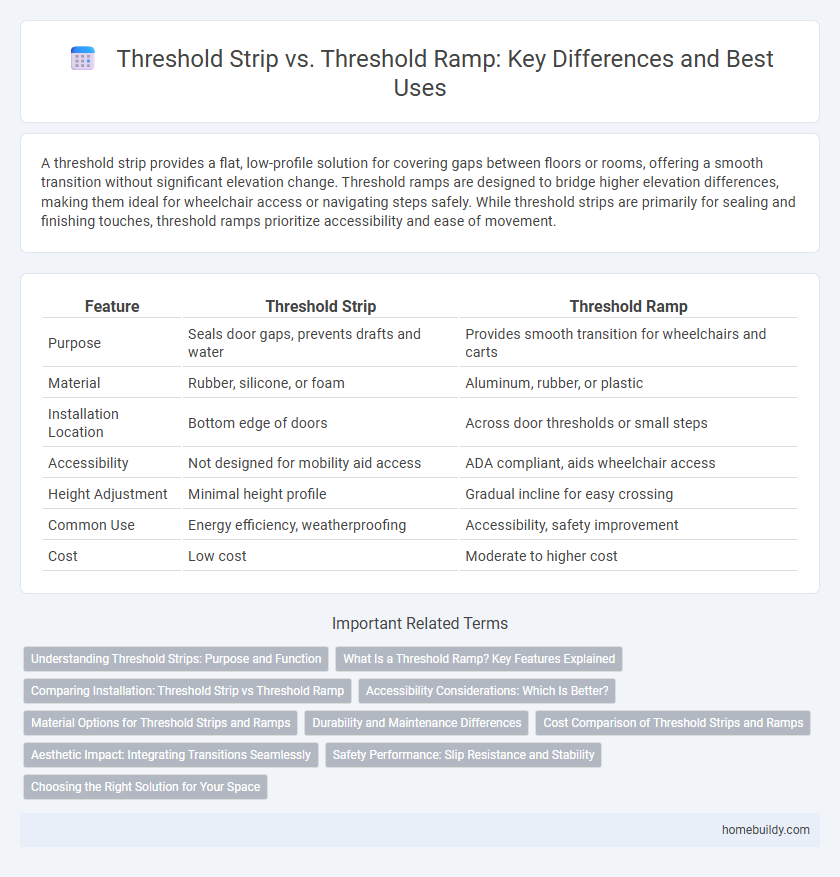A threshold strip provides a flat, low-profile solution for covering gaps between floors or rooms, offering a smooth transition without significant elevation change. Threshold ramps are designed to bridge higher elevation differences, making them ideal for wheelchair access or navigating steps safely. While threshold strips are primarily for sealing and finishing touches, threshold ramps prioritize accessibility and ease of movement.
Table of Comparison
| Feature | Threshold Strip | Threshold Ramp |
|---|---|---|
| Purpose | Seals door gaps, prevents drafts and water | Provides smooth transition for wheelchairs and carts |
| Material | Rubber, silicone, or foam | Aluminum, rubber, or plastic |
| Installation Location | Bottom edge of doors | Across door thresholds or small steps |
| Accessibility | Not designed for mobility aid access | ADA compliant, aids wheelchair access |
| Height Adjustment | Minimal height profile | Gradual incline for easy crossing |
| Common Use | Energy efficiency, weatherproofing | Accessibility, safety improvement |
| Cost | Low cost | Moderate to higher cost |
Understanding Threshold Strips: Purpose and Function
Threshold strips serve as a protective barrier between different flooring surfaces, preventing wear and damage at doorways and transitions. Designed for durability, these strips provide a smooth, level surface that enhances safety by reducing tripping hazards. Unlike threshold ramps, threshold strips primarily focus on sealing gaps and ensuring a clean finish rather than accommodating steep elevation changes.
What Is a Threshold Ramp? Key Features Explained
A threshold ramp is a sloped transition piece designed to bridge differences in floor height, facilitating smooth movement over door thresholds for wheelchairs, carts, and strollers. Key features include non-slip surfaces for safety, durable materials such as rubber or aluminum, and customizable sizes to fit various threshold heights and widths. Unlike threshold strips, which are flat and primarily seal gaps, threshold ramps prioritize accessibility and ease of movement across elevation changes.
Comparing Installation: Threshold Strip vs Threshold Ramp
Threshold strips install directly on doorways to provide a low-profile seal that is easy and quick to fit, often requiring only adhesive backing or simple screws. Threshold ramps demand more precise measurement and mounting, usually involving secure bolting to accommodate varying ramp slopes for wheelchair accessibility. While threshold strips excel in straightforward installation for sealing and minor elevation differences, threshold ramps require more preparation to ensure stability and compliance with ADA regulations.
Accessibility Considerations: Which Is Better?
Threshold strips provide a sleek, minimalistic transition between flooring surfaces, often preferred for doorways with slight elevation differences, but may pose challenges for wheelchair users due to their raised edge. Threshold ramps, designed with a gentle slope, enhance accessibility by enabling smooth passage over door thresholds and reducing trip hazards, making them more suitable for people with mobility impairments or those using wheelchairs. For optimal accessibility, threshold ramps generally outperform threshold strips by facilitating safer and easier navigation across thresholds.
Material Options for Threshold Strips and Ramps
Threshold strips and threshold ramps are typically crafted from materials such as aluminum, rubber, wood, and vinyl, each offering distinct advantages in durability and aesthetics. Aluminum threshold strips provide lightweight strength and corrosion resistance, while rubber options enhance slip resistance and shock absorption, ideal for high-traffic or outdoor areas. Vinyl and wood offer customizable appearance options, with vinyl delivering water resistance and wood ensuring a traditional, polished look for interior spaces.
Durability and Maintenance Differences
Threshold strips typically offer greater durability than threshold ramps due to their solid, compact design crafted from robust materials like aluminum or rubber, which withstand heavy foot traffic and weather exposure. Maintenance for threshold strips is minimal, often requiring only occasional cleaning and inspection for wear, while threshold ramps may demand more frequent upkeep due to their adjustable or modular components that can loosen or deteriorate. The simpler construction of threshold strips results in fewer maintenance challenges and longer-lasting performance in both residential and commercial settings.
Cost Comparison of Threshold Strips and Ramps
Threshold strips generally offer a more cost-effective solution compared to threshold ramps, with average prices ranging from $10 to $50 depending on material and length, whereas threshold ramps typically start at $40 and can exceed $150 for heavy-duty models. Installation costs for threshold strips are usually lower due to their simpler design and quicker setup, while ramps may require additional anchoring or support, increasing labor expenses. Choosing between these options depends on budget constraints and specific accessibility needs, with threshold strips favored for low-cost, minimal elevation changes and ramps preferred for higher elevation transitions.
Aesthetic Impact: Integrating Transitions Seamlessly
Threshold strips provide a sleek, low-profile transition that preserves the visual continuity between flooring surfaces, enhancing the overall aesthetic appeal of a room. Threshold ramps, while functional for accessibility, typically have a more noticeable incline that can disrupt the seamless flow of design elements. Choosing a threshold strip allows for a subtle integration that complements interior decor without drawing attention to flooring changes.
Safety Performance: Slip Resistance and Stability
Threshold strips provide superior slip resistance due to their textured surface, enhancing safety in both residential and commercial settings. Threshold ramps, while beneficial for accessibility, may offer less stability and increased risk of slipping if not equipped with adequate anti-slip materials. Prioritizing materials like rubber or metal with high friction coefficients ensures optimal safety performance in threshold design.
Choosing the Right Solution for Your Space
Threshold strips provide a low-profile, durable solution ideal for doorways with minimal height difference, ensuring a smooth transition while maintaining accessibility and preventing tripping hazards. Threshold ramps, designed to bridge larger height gaps, offer gentle inclines that comply with ADA standards, making them suitable for wheelchair users and enhanced mobility. Selecting the right product depends on the specific height variance and accessibility requirements of your space, with threshold strips favored for subtle transitions and ramps essential for inclusive design.
Threshold strip vs Threshold ramp Infographic

 homebuildy.com
homebuildy.com